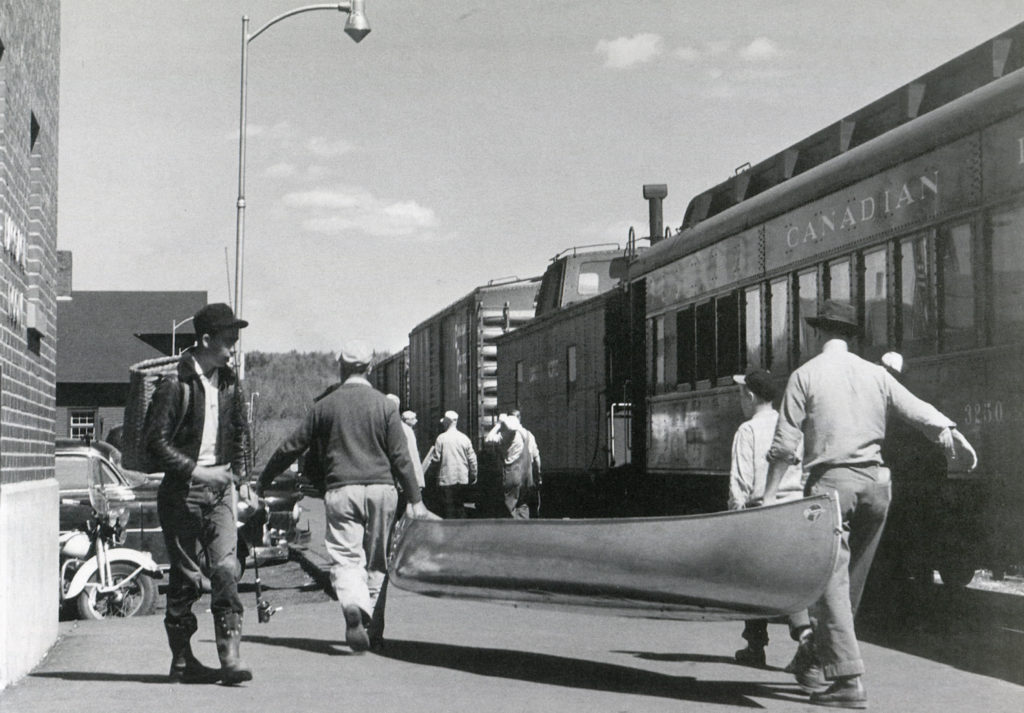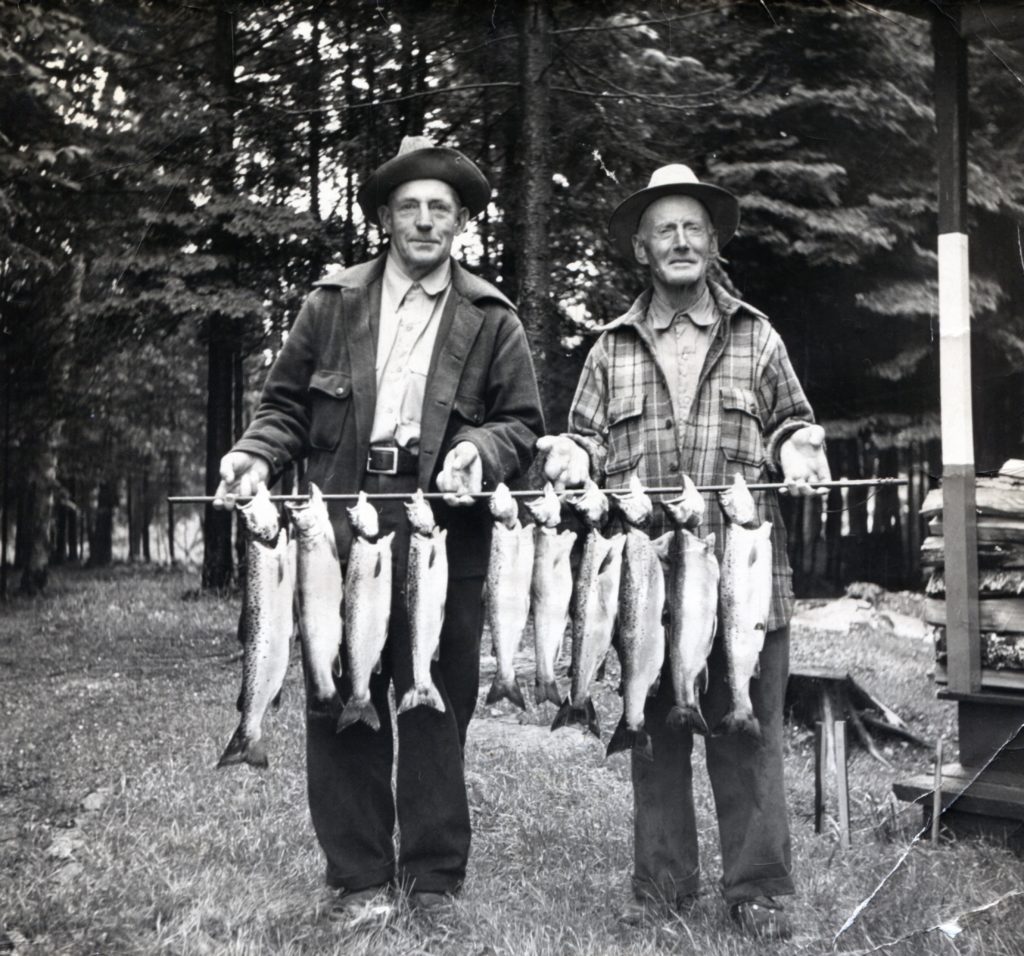
Tapping Vacationland’s historic roots
Maine’s legacy as an outdoors destination could speed its economic recovery
By Lori Valigra
Bangor Daily News Staff
Hiram Ricker didn’t know he was starting what would become a world-famous water company when he drank from a spring reported to have healing properties. Sickly with stomach problems, the grandson of the original owner of the Poland Spring resort heard a cow was saved by drinking water from the spring, and he followed suit.
Quickly cured, he shared the news with his doctor, and the two started selling bottled water in 1845, branding it as a cure-all that “drives out all humors and purifies the blood.” The bottle sales in Boston, Philadelphia and New York also boosted tourism to Poland.
Tourism’s rise to become one of Maine’s top industries began long ago, but the reasons people flock here — clean water, fresh air and outdoor activities — have mirrored that history during the coronavirus pandemic. While tourism statewide was down more than 30 percent this year, it has recovered from the Great Depression and other calamities in the past. Some areas popular then bucked trends to see visitors increase in 2020.

SCOOT TRAIN — The Canadian Pacific Railroad’s “Scoot” train offloads sportsmen at West Cove Junction Wharf, where they are taken by steamboat to various sporting camps located on Moosehead Lake. The Scoot was the last train in New England to be powered by steam.
Visitors are increasingly seeking the space and adventure that abounds in rural areas, hearkening back to the reasons the earliest tourists, including author Henry David Thoreau, visited the state. Maine tourism experts said that history and ongoing marketing efforts during the pandemic may accelerate the recovery once people began traveling in earnest again.
The first big rush of Maine tourism began in the early 1800s toward the end of the Industrial Revolution, which brought new wealth and leisure time to people who had thronged to cities to work. Sweltering summer heat, poor sanitary conditions and disease sparked a travel trend from major eastern cities to Maine, considered a pristine area where people could rejuvenate and “rusticate,” or rough it, often for a summer. Surges came at the end of the Civil War in 1865 and after the advent of automobiles in the 1890s.
Some of the places that thrived then did again in 2020. Greenville, at the lower end of Moosehead Lake, saw visits increase 40 percent from June through August of this year compared to 2019. Rangeley, which has experienced a population boom, saw visitors rise by 39 percent. They rose 36 percent in the summer and ski town of Bethel. Maine state park campground reservations were up 32 percent.
“If people are traveling, they tend to look for places that are safe, have wide-open spaces, outdoor recreation and are in rural locations,” Steve Lyons, director of the Maine Office of Tourism, said.
The earliest tourism numbers are not available, but by 1924 some 650,000 people brought $67.5 million into the state, according to the Maine Publicity Bureau’s annual report that year. The bureau, set up in 1921 to promote Maine tourism, preceded today’s Maine Tourism Association, a member organization. The amount spent may not sound like a lot, but it is equivalent to more than $1 billion today.

1940S FISHING TRIP — Two fishermen show off a day’s catch at Tomhegan Camps at Moosehead Lake circa 1940s.
The moniker “Vacationland” first appeared on Maine license plates in 1936, though it is not clear how it originated. Tourists spent $6.5 billion last year, supporting one in six jobs here. This year’s pandemic restrictions caused a 32 percent drop in visits on average statewide over the summer, according to preliminary data from the Maine Office of Tourism.
Maine’s tourism industry had seen record-breaking growth each year since the Great Recession ended in 2009, and had been on track to see another hot year in 2020 without the pandemic, Tony Cameron, CEO of the Maine Tourism Association, said. But he’s optimistic that Maine’s efforts to market itself as a safe destination, including a $2 million advertising campaign, will give it an advantage when people are ready to travel again.
Tourism has had peaks and dips here before, including during the Great Depression from 1929 to 1933, Maine state historian Earle Shettleworth said. An article in the Aug. 26, 1932, edition of the Lewiston Evening Journal talks about tourism being down 20 percent that year.
It describes a guest who once stayed at a large resort hotel and “thought nothing of spending $15 or $20 for flowers alone for a dinner party” but now was washing dishes in the hotel kitchen and was glad for the work.
Lyons said it is impossible to predict when the tourism industry will recover, but the U.S. Travel Association is predicting that people may start traveling widely again in the spring and that leisure travel should recover to pre-COVID levels by 2023 or 2024.
“In some ways tourism in Maine has stayed the same over the last 200 years,” Shettleworth said. “People are attracted to the fresh air and clean water.”
Visitors in the mid-1800s often stayed in rustic farmhouses that typically lacked indoor toilets and plumbing. They traveled to rural parts of Maine via train, steamboat and horse-drawn carriages. Thoreau, a writer and naturalist, was one of the most well-known early visitors to the Moosehead area, exploring the Wabanaki canoe routes using Penobscot guides.
“Thoreau may in some ways be the first outside tourist to the interior Maine woods and waters with significant influential ties,” said Suzanne AuClair, executive director of the Moosehead Historical Society and Museums in Greenville, which holds an annual festival celebrating Thoreau’s journey canceled this year during the pandemic.
She said what Thoreau wrote about the region, made famous in his 1864 book “The Maine Woods,” helped give a “branded identity to attract outdoor recreators into northern Maine, from Moosehead to Katahdin.”
The Wabanaki people also summered on Mount Kineo near the lake to hunt, fish and make tools from rhyolite, a strong rock found in the region. Later, when entrepreneurial investors built the Mount Kineo House in Greenville, the Wabanaki served as guides for sportspeople and made and sold souvenirs to tourists staying at what at the time was a grand hotel, AuClair said. Different versions were built after it burned twice, the most elaborate by the Ricker Hotel Co. in 1912, she said.
The Ricker family also owned the Poland Spring Resort. Jabez Ricker bought the Poland property in 1794. Cynthia Robbins, the current owner of the Poland Spring Resort, said the resort got started when a traveler on the way to South Paris stopped at the nearby Shaker colony and asked for lodging. Shakers didn’t allow outsiders to stay the night, so the person came to the Ricker house and asked for a meal and a place to sleep. One of the Ricker children decided to build an inn in 1797.
“That was the beginning of tourism in Poland,” Robbins said.
The inn, which had only shared bathrooms, was on Longfellow Trail stretching from Portland to Quebec City. Other buildings, including a horse stable, were built along the road, which is now Route 26.
In 1876 the Rickers opened another hotel closer to the spring with 350 guest rooms and a dining room that would feed 500 guests. The hotel, and others like it across Maine, attracted the wealthy and dignitaries, particularly during the Gilded Age from 1870 to 1900, marked by rapid economic growth in the northern and western United States.
Tourism changed greatly from the late 1890s to the early 1900s as automobiles replaced horses and trains, and later as an intricate road system took shape around the country after World War II.
It’s a change whose ramifications are still playing out in hot tourist spots like Bar Harbor and the rest of Mount Desert Island. The area drew the well-heeled from all over the world who saw the mid-1800s work of painters including Thomas Cole and his followers Frederic Church and Fitz Lane. Until 1918, Bar Harbor was aptly known as Eden.
“Initially, people were looking to escape urban and industrial development and get into a more natural setting,” Raney Bench, executive director of the Mount Desert Island Historical Society, said.
In the 1840s lodging houses popped up in Somesville, which was mainly a fishing village. Hotels followed, but Bench said they initially lacked sanitation, with kitchen scraps and waste water thrown into shallow pits dug behind hotels. A few times there were some disease outbreaks, especially with people whose rooms faced the pits, she said.
But the draw of the wealthy, including the Rockefeller family, to both Bar Harbor and Mount Desert Island led to grand hotels and cottages being built, and eventually, to cars coming. In the opinion of some, there were too many cars, and that led to a 16-year debate among islanders and summer residents.
A Feb. 1, 1909, article in the New York Times described how summer residents John D. Rockefeller Jr. and Joseph Pulitzer petitioned the state Legislature in favor of a law that would let islands ban cars. Summer residents were threatening to close their homes and move elsewhere if cars were not allowed. The ban went into effect but was lifted in 1916.
That was after hotel owners as far south as Camden, Rockland and others up the coast sent letters to Bar Harbor to demand that the auto ban be lifted, since people were not stopping at their hotels because they could not go on to Bar Harbor. Instead they were vacationing in Newport, Rhode Island, or Niagara Falls, New York.
One honeymoon couple who drove from New York to Camden during the ban discovered they would not be able to drive their car in Bar Harbor. With help from Camden residents they found a workaround, Bench said.
They hitched a horse to the front of the car to drag it to the hotel in Bar Harbor. But the horse couldn’t pull the car up the hill to the hotel and the chauffeur had to start the car. They had to pay a fine.
The opening of Lafayette National Park in 1919, renamed Acadia National Park 10 years later, and other destinations throughout the state opened up tourism as an activity for everyone, not just the rich.
This summer and fall, the park became a safe haven for those feeling hemmed in by the pandemic and searching for fresh air. Monthly visits to the park more than doubled from June to July but still lagged well behind visit totals from 2019, a decline attributable to the pandemic.
Still, there were enough traffic jams for the park to try a temporary reservation system in October for private vehicles on Cadillac Mountain and Ocean Drive. It will require reservations next summer for motorists who want to drive to the top of Cadillac Mountain and is likely to require vehicle reservations for Ocean Drive, a scenic stretch of the Park Loop Road with popular sites such as Sand Beach and Thunder Hole, in 2022.
Earl Brechlin, a Maine author and president of the Bar Harbor Historical Society, finds that ironic. He said the early tourists also had to make reservations to take a buckboard wagon to the end of Eagle Lake, a steam boat across it and a cog railroad to the top of Cadillac Mountain.
“So it’s one of those things where the more things change, the more they stay the same,” he said.